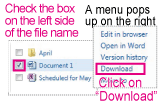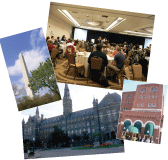|
 |
■Bioresources information is available at the following URLs
|
 |
|
Introduction to Resource Center <No.40> Messages from the new representatives of the core institutions in the 3rd stage NBRP
The National BioResource Project (NBRP) was inaugurated in 2002, and it entered the 3rd stage in April this year.
This month's newsletter contains self-written introductions and ambitions of 5 representatives from the resource institutions that have newly entered this latest phase of the NBRP.
Rats
Takashi Kuramoto (Institute of Laboratory Animals, Graduate School of Medicine, Kyoto University) |
Self-introduction: I was born in Osaka in 1967, and I graduated from the Department of Animal Husbandry Resources, Faculty of Agriculture, Kyoto University (Thus I can drive cattle!). I was interested in taking classes of laboratory animal science during my undergraduate days, and hence, decided to embark on this career. Currently, I am involved in administration, education, and research work on laboratory animals in my institution (Director: Prof. Tadao Serikawa). I have specialized in rat genetics, particularly in the genetic analysis of rat disease models and in the elucidation of pathogenic mechanisms. I have participated in both the 1st and the 2nd stage NBRP under Prof. Serikawa.
Ambition: We will steadily promote the project consolidated in the 1st and 2nd stage NBRP. In addition, we will propose research ideas that take full advantage of the institutional resources, such as the inter-strain screening of disease-sensitive genes and specific phenotypic traits and the elucidation of the difference between genotypes and phenotypes of sublines. Furthermore, we would also like to take on crossover research that exploits bioresources derived not only from rats but also from other resources. We will do our utmost to meet the users’ expectations.
|
|
Drosophila
Ryu Ueda (Genetic Strains Research Center, National Institute of Genetics)
After the retirement of Prof. Masatoshi Yamamoto, Kyoto Institute of Technology (KIT), we, as the core institution, undertook the 3rd stage NBRP Drosophila project. The Drosophila resource project in this stage will be organized by a consortium of 5 institutions. This includes the 4 institutions from the previous stages (NIG, KIT, Ehime University, and the Kyorin University) and an additional institution, the Miyazaki University, where the backup of DNA resources will be preserved.
NBRP Drosophila has developed into a world-scale project in terms of the number of strains of this organism that have been preserved in the last 10 years. We have been providing numerous researchers with Drosophila strains on a daily basis. These strains are useful in genetics-based life science research and include historic strains that have been collected in the past century of study on Drosophila genetics and other strains subjected to the recent genome sequencing. Recently, systematic mutant libraries have also been developed globally by applying novel genetic engineering technologies. Under global collaborations, we will endeavor to improve the quality of these resources, which can be utilized in cutting-edge research at institutions worldwide.
Wheat
Shuhei Nasuda (Graduate School of Agriculture, Kyoto University)
As a representative of the core institution, I oversee the 3rd stage NBRP Wheat project at Kyoto University. I have specialized in molecular cell genetics of the wheat family, which includes staple crops such as wheat and barley. Thus far, my primary research focus has been chromosome mapping of genes and molecular markers; therefore, strains with heteroploids and structurally abnormal chromosomes maintained by NBRP Wheat are indispensible resources.
NBRP Wheat preserves over 12,000 seed resources and 780,000 DNA clones. These resources have been collected during the 1st and 2nd NBRP, in addition to the preceding bioresource preservation projects. Our duty is to provide access to these collections in a user-friendly manner. Aiming at further improving the added value and quality of the preserved strains, we will construct a framework for preserving and distributing resources with phenotype and genotype information that can be immediately used in research. In this manner, we will provide a service that meets the requirements of a diverse range of users.
Algae
Masanobu Kawachi (National Institute for Environmental Studies)
|
We are responsible for the 3rd stage NBRP Algae platform. I have been consistently involved in algae research since my college days. I was previously responsible for the administration of culture collections of algae, which were used in various applications at the Marine Biotechnology Institute, Co., Ltd., Kamaishi, Iwate. I then moved to NIES, my current workplace, and I am in charge of the algae collections at the laboratory of Dr. Fumie Kasai, the predecessor of the project, in addition to other research projects related to algae.
Because of Dr. Kasai's past efforts, domestic algae resources were consolidated and additional value and information on the preserved strains were improved. As a result, we could develop a system, using which a variety of algal strains of the principal taxonomic groups can be preserved and distributed. As of April 2012, NBRP Algae released 2,664 preserved strains, which includes 870 species and 443 genera, and 50 of the class-level major divisions. In the 3rd stage, we will continue and further improve our past activities and initiate new tasks such as enhancement and consolidation of model organisms and candidate strains for preservation. In collaboration with the researchers at NBRP, algae research communities, and institutions that preserve bacterial strains, we will promote the diversity and importance of algae and tackle resource management from a user’s viewpoint. We will work interactively with our user base, in order to achieve these goals. |
|
Pathogenic Microorganisms
Takashi Yaguchi (Medical Mycology Research Center, Chiba University)
My role is to oversee the NBRP Pathogenic Microorganisms branch of the program. Pathogenic microorganisms comprise a wide range of organisms such as fungi, bacteria, and protozoa, and thus, they cannot be managed by a single institution. Therefore, Chiba University, the core institution, is responsible for the management of fungi and Streptomycetes, whereas the sub-institutions, including the Osaka University and the Gifu University, manage bacteria, and the Nagasaki University manages protozoa. Each institution systematically collects, preserves, and distributes the resources.
We aim at developing pathogenic microorganism collections that can be useful in tackling the challenges of future infectious diseases by preserving (1) standard strains, (2) highly pathogenic strains, and (3) fresh clinical isolates at all the institutions. In addition, we have been sharing information on operations such as preparation of material transfer agreements, adoption of the new Infectious Disease Control Law, construction of a system to analyze the actual cost for resource distribution, and recruitment and training of professionals, which we are undertaking as our common task. We will continue to comply with the requests from research communities and endeavor to increase the number of users. We greatly appreciate opinions and comments from all the users. |
|
|
Saving data in cloud |
| |
Using SkyDrive on a web browser
After receiving an email that confirms the registration of your account, enter your Windows Live ID and password on the SkyDrive website to sign in. Here, functions are available for uploading and downloading files.
①To upload files
Click on the "Add files" button in the menu at the top and drop the file to be uploaded. A file selection window may appear, depending on the browser; if so, select the file to be uploaded (Fig. 1).
Microsoft Office Web Apps (partial function: Fig. 1A)
By using SkyDrive on a web browser, Word, Excel, PowerPoint, or OneNote can be used on PCs in which Microsoft Office has not been installed.
②To download files
Upon checking the box to the left of the file name, a menu pops up on the right-hand side. Click on "Download" in this menu (Fig. 2).
③Sharing files
To share files, select the file to be shared and click on "Share" in the pop-up menu on the right-hand side. Next, if a window appears for setting the sharing method, click on "Get a link" (Fig. 3). By selecting the sharing method and obtaining a link, a file can be displayed and saved through the link.
To stop sharing a file, select the file and click on the "x" button in the share category of the pop-up menu on the right-hand side (Fig. 4).
Using SkyDrive apps
SkyDrive apps need to be installed. From the SkyDrive app website (https://apps.live.com/skydrive), download "Set up program" by clicking on the button to obtain the app and run the program. Enter your Windows Live ID and password to sign in.
Next, designate a local SkyDrive folder that needs to be synchronized with the server. If the folder needs to be changed, click on the "Change" button (Fig. 5). This will complete the installation.This will complete the installation.
Since the folders are automatically synchronized, if a file in the SkyDrive folder of the server is deleted, the file in the local SkyDrive folder will also be deleted automatically. Therefore, please be careful while deleting a file.
|

Fig. 1. Uploading a file.

Fig. 2. Downloading a file

Fig. 3. Obtaining URL for sharing files.

Fig. 4. Cancellation of file sharing

Fig. 5. Designation of a folder to be synchronized with the SkyDrive |
| |
Notes on the use of online storage
- Be sure to release files only after checking their usage. Your account may be terminated if copyrighted files are released.
- Be sure to back-up files that are to be uploaded. When the service or your account is suspended, files on the server could be deleted.
|
|
Please try to use SkyDrive, through which data can be easily transferred among PCs while saving files in a cloud.
(Hiroki Watanabe) |
|
Report on the 5th International Biocuration Conference -- April 2-4, 2012 Washington DC, USA -- |
Biocuration 2012, the Fifth International Biocuration Conference, was held at the Georgetown University Hotel and Conference Center, Washington D.C., USA, from April 2–4. The conference attracted a record number of 307 participants from 17 countries, 80% of whom came from the USA or UK, and 6 from Japan. The entire conference was a fulfilling event, with 3 plenary talks given by Dr. Mark Yandell, Dr. Fritz Roth, and Dr. Amos Bairoch, 7 sessions, 4 workshops, and 159 titles of poster sessions. The agenda of the conference has been posted on the website, http://pir.georgetown.edu/biocuration2012/. We were seated at round tables, where we also had our meals; this arrangement allowed us to communicate and exchange information effectively. I drew much inspiration from this conference. (Yukiko Yamazaki)
|

|
|
"Dynamic Equilibrium 2 -- Can life be free?" Shinichi Fukuoka (Kirakusha, 2011) |
The book is a sequel to "Dynamic Equilibrium" ("Doteki Heiko" in Japanese), written by Dr. Fukuoka, who is now a best-selling author. His unique writing style is even more apparent and the book makes for a pleasant reading experience. It contains plenty of intellectual and interesting topics such as gut flora, pheromones, pollen allergy, and differences between a water filter and a kidney. The author's viewpoint underlying these topics, i.e., dynamic equilibrium (continuous entities in the perpetual flow of time), is not the same as that of Descartes’ , i.e., of mechanical beings.
The author indicates that his viewpoint of life as dynamic equilibrium is derived from the experiment of Dr. Rudolph Schoenheimer, a biochemist from the 1930s. As a result of tracing isotope-labeled amino acids administered to mice, the labeled molecules were identified from the entire body of the mice. This implies that the amino acids were incorporated into various proteins that were newly synthesized and distributed to the entire body of the mice, whereas approximately the same quantity of proteins were decomposed and eliminated. In this manner, substance metabolism in the body was observed directly and experimentally.
The author says that "life has given up constructing robust structures in order to maintain the order." Instead, “system of life has preliminarily supposed an accumulation of errors and resulting disorders and therefore will destroy and recreate itself before the law of increasing entropy destroys the order." In addition, the author states that "there is no causality or determinism in dynamic equilibrium, i.e., life” and thus "the life is free." Furthermore, "beauty resides in the dynamic equilibrium!" (K.N.)
|
(This book is only Japanese.) |
|